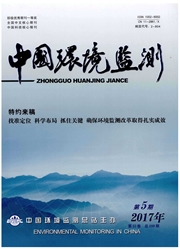

 中文摘要:
中文摘要:
2011年4月通过GC—MS检测和210Pb测年对灌河口海域沉积物(GHES)中的PAHs进行了分析,柱状沉积物中21种PAHs总浓度为21.0—209.0ng/g,均值为88.1ng/s,7种致癌PAHs浓度为7.0~90.0ng/g,其中致癌剂苯并[a]芘浓度为ND-2.0ng/g。PAHs浓度与沉积物中有机质含量呈低度正相关,与pH无明显相关性。源解析表明,近50年来GHES中的PAHs大部分来自煤和生物质燃烧。近50年来,总PAHs和16种优控PAHs浓度在波动中升高;近年来苊、苊烯、苯并[b]荧蒽、荧蒽、茚并[1,2,3-cd]芘的浓度增高,需查明来源。生态风险评价表明,GHES中以芴为主的负面生物毒性效应会偶尔发生。芴、苯并[b]荧蒽、苯并[k]荧蒽的浓度介于临界与偶然效应浓度值之间,应尽量减少对该海域沉积物的搅动,防止污染物再悬浮导致水体的二次污染。
 英文摘要:
英文摘要:
Surface and column sediment samples were collected from Guanhe Estuary (GHE) to determine 21 kinds of PAHs by GC-MS and noPb dating methods in April,2011. The results showed that: total concentrations of 21 PAHs from column sediments ranged from 21.0 to 209.0 ng/g ( dry weight) ,with the average of 88.1 ng/g. 7 carcinogenic PAHs concentrations were from 7.0 to 90. 0 ng/g,and concentrations of Benzo(a) pyrene (BaP) were from ND to 2.0 ng/g. PAHs concentrations were positively correlated with the organic matter,and had nothing to do with pH. In the past 50 years,concentrations of 21 PAHs,especially 16 priority PAHs,increased fluctuatingly,and PAHs in GHE mainly came from combustions of coal and biomass. In recent years, concentrations of Acenaphthene (ACE) , Acenaphthylene ( ACY ) , Benzo [ b ]fluorathene (BbF) and Fluoranthene ( FLA ) increased to some extent. Risk assessment showed that adverse biological risks caused by fluorene (FLO) would occur occasionally. Concentrations of FLO,BbF and BkF were between TEL and OEL. Reducing sediments stirring could avoid particle resuspension and reduce PAHs pollution of water body.
 同期刊论文项目
同期刊论文项目
 同项目期刊论文
同项目期刊论文
 期刊信息
期刊信息
